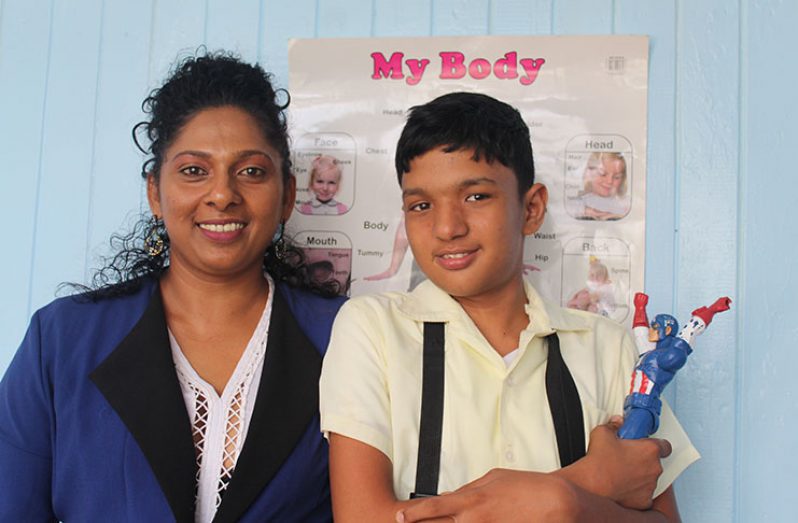– mother shares her experience raising autistic child
EVEN though physically he looked perfect, his mother–Anjalena Beshpatty–knew something was wrong with her second child, Sameir, and it was a problem which no doctor at the hospital at the time was able to pinpoint.
Maybe it was because Sameir was her second child, Anjalena knew what developments to expect as he grew or maybe it was her maternal instincts kicking in, but the mother knew that all was not well with Sameir.
At about two years of age, he was not behaving as his sister did; he was not walking as yet and he seemed unable to interact easily.
Speaking to Guyana Chronicle, Beshpatty related that she was informed that Sameir could have autism after she took him to a medical outreach programme where he was examined by a doctor from overseas.
“That was the first time I heard the word autism. I had no idea what autism meant,” she recounted, and added, “Even when the doctor explained, I couldn’t comprehend [it] until I went to do some research on the Internet.”
This research led her to the Modified Checklist for Autism (otherwise known as M- Chat) which she filled out many times, in denial, but later realising that her son did indeed have the signs and symptoms associated with the problem.
According to the World Health Organisation (WHO), Autism Spectrum Disorders (ASD), commonly called autism, refer to a wide range of conditions characterised by some degree of impaired social behaviour; communication and language; and a narrow range of interests and activities that are both unique to the individual and carried out repetitively.
These disorders begin in childhood and tend to persist into adolescence and adulthood and may be mild, moderate or severe. In most cases, the conditions are apparent during the first five years of life.
DIFFICULT TO ACCEPT
“It was very difficult to accept for me. Even after so many years, there are still times when I struggle with knowing my child has all these challenges,” the mother stated.
Sameir, who has moderate to severe autism, was confronted with the challenge of performing even simple tasks that come almost natural to the average child.
And maybe these challenges will continue to confront him because there is no cure for ASD. However, there are steps that can be taken to help him adapt and overcome these challenges.
His road to rising above his challenges began with Anjalena’s decision to put her “expectations” aside and strive to give Sameir the best life that she possibly could within his spectrum.
She decided not to isolate him and enrolled him at a play school where he spent three years before moving into a nursery school where he spent another three years.
Her goal was to have him experience what interaction with other children in society felt like. According to her, those six years were instrumental in making Samir the person that he is today because he was able to acquire social skills.
Proudly, Beshpatty asserted: “He always has a smile on his face, he hugs everyone and he is so social. He can interact with other children.”
CAN UNDERSTAND BUT CANNOT COMMUNICATE
The boy, however, has receptive language skills but not expressive language skills, according to his mother, which means that he can understand what is communicated to him but not cannot effectively express himself verbally or non-verbally.
As such, over the years, he was taken to speech therapy sessions at the Ptolemy Reid Rehabilitation Centre.
It was here at the Ptolemy Reid Centre that Anjalena first heard about the Step by Step Foundation, a registered charity that works with children aged three to 12 who have autism.
When Anjalena and Sameir encountered the foundation, it had just been established by a former British High Commissioner to Guyana and his wife, who themselves have a son with autism, since there were no facilities in Guyana that managed the condition. The foundation opened up in 2011 and has had, and continues to have, a professional liaison with Dr. Jim Ellis, a U.S. clinical psychologist and expert in autism, as well as access to autism treatment.
While Dr. Ellis is not a resident of Guyana, he provides his services free of cost to the foundation by visiting Guyana about four times a year, and trains the tutors and holds weekly skype sessions to track the progress and development of the children and even tutors, as related by chairman of the foundation, Dr. Suraiya Ismail. Dr. Ellis was tapped because, as related by the chairperson, there is no real leeway for the “elaborate” diagnosis here.
Ismail further related that the school uses an individualised-based Applied Behavioural Analysis (ABA) approach at its core, alongside a mix of occupational and speech therapy to improve the communication, social and behavioural skills of children with autism, targeting the needs of each child.
Just as during Sameir’s time in the play and nursery schools, Anjalena devoted her time to being with her son at the new institution. And because of her evident devotion and the knowledge she had garnered over the years, Dr. Ellis began training her as a tutor and streamlined further training for her in the USA.
“I had so much knowledge already and I wanted not only to work with Sameir but to share it with other children. I went to Boston and got more training, independently funded, because I wanted to learn,” the mother posited.
Since its initiation in 2011, Anjalena has worked with the foundation and was there as it progressed into a school seeking to cater for the needs of more children.
Over the years, Anjalena has honed these skills, amassed more knowledge and is now a senior tutor here.
Understanding that communication is perhaps “100 times more difficult” for children with autism, is pertinent to focus attention on this shortcoming.
She explained that simple tasks that people do almost naturally, such as putting on a sock, need to be broken down into minute steps that can be learned by the children.
Using the ABA methodology crafted to facilitate behaviour modification, the mother explained, “As tutors, you have to find different ways to teach the children. Never underestimate the children and watch them surprise us every time.”
According to her, each child needs individualised care which means that parents or guardians might have to tweak the programmes just a bit to suit them.
Since learning that Sameir has ASD more than 10 years ago, Anjalena left her job and focussed on caring for her son. Nowadays, Sameir can dress himself, communicate through communication devices and express himself to a greater degree.
For her, seeing her son progress is the best reward she can have. All the taunts of having a “retarded” or “disabled” son mean nothing to her since she focuses on him. She has transformed her situation into one in which she can readily assist others in the same situation.
“Sameir has given me the purpose of my life,” Anjalena affirmed.




.png)









